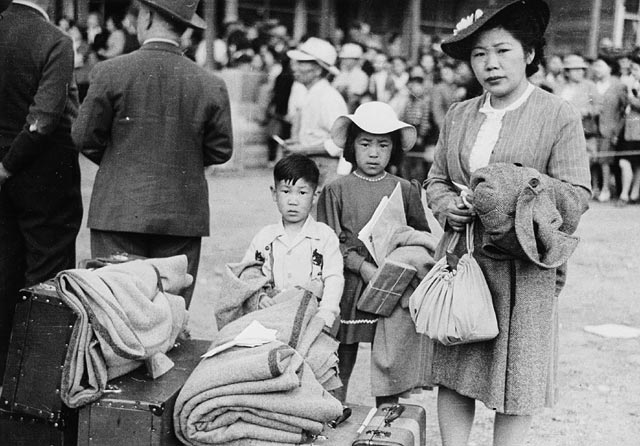1939-1952
Introduction to Internment: Viewing Photographs
Students analyze photographs to gain knowledge about the Japanese Canadian experience.
 Scroll down
Scroll down
Why
Know
- Past discriminatory government policies and actions towards Japanese Canadians (internment)
Do
- Ask questions, corroborate inferences, and draw conclusions (Evidence)
- Assess significance of people, places, events, or developments (Historical Significance)
- Sequence events and recognize the positive and negative aspects of continuities and change in the past and present (Continuity and Change)
Core Skills
- Identify how the actions of others affect community (Social Responsibility)
- Explain when something is unfair (Social Responsibility)
First People’s Principles of Learning
- Learning involves recognizing the consequences of one’s actions
How
Note: Internment begins! Remember to remove your avatars before this lesson. This is the part where you tell how Japanese Canadians were removed from BC’s coast. Leave lots of time to unpack this.
-
Teacher introduces a photograph below to the class and
models the role of a “detective” or “reporter.”Using the 5Ws
and H poster, the teacher leads the discussion by asking
questions such as:
- Who is in the picture? How does each person feel about what is going on? How do I know this (facial expressions, body language, situational clues)?
- Where is this scene happening? How do I know this? (What is the evidence?)
- When is this happening? How do I know this? Could this happen today?
- What is happening in this picture? What is going on? What is the story? How do I know this? (What clues are there to tell me this?)
- Why is this happening? What events led up to this moment? How do I know this?
- Teacher reads the historical background for the photo.
- Divide the class into small groups to view additional photos. Tell students they are detectives or reporters. They are to view and analyze the photographs using the 5Ws and H and write their findings on Handout.
- Students report their findings to the class.
- After discussing each photo, the teacher reads the information for each photo to the students.
- The teacher tells the students of how Japanese Canadians were forcibly moved off the coast in 1942. Teacher reads “Japanese Canadian History 1942–1988” with the students. You might want to stop telling the students what happened when you get to the part about the government selling off Japanese Canadians’ possessions so the students can experience it themselves through the Powell Street simulation. At this point in the simulation, students and the avatars believed that their homes and possessions would be held in trust – as did Japanese Canadians – by the Canadian government.
- Optional: For more information, the teacher could play some of Mary Kitagawa’s interview videos about going into internment, (especially videos 6, 7 and 8).
- Discuss. (See suggested questions below in Assessment Considerations.)
- Students complete journal reflection. (See suggested journal reflection prompts below in Assessment Considerations.)
Assessment Considerations
GENERAL COMMENTS AND CONSIDERATIONS
- Assess based on students’ discussions, their viewing sheets, and their journal entries. They are now starting to form a concept of fairness and loss based on evidence (from photos), discussion, and experience (through the simulation).
SUGGESTED DISCUSSION QUESTIONS
- What are some differences between your first observations and the new information?
- What surprised you the most?
- Was this fair? Why or why not?
- What is your idea of fairness (now)?
- What was it like to lose your home, your possessions, and your community due to prejudice? How do you deal with this kind of loss?
SUGGESTED JOURNAL REFLECTION PROMPTS
- What is your idea of fairness (now)?
- What was it like to lose your home, your possessions, and your community due to prejudice? How do you deal with this kind of loss?
SUGGESTED TASK
- Viewing Sheet
ALTERNATIVE SUGGESTED TASK
- Think like a reporter and write headlines and news stories based on the photographs they saw. Remember the 5Ws and H.
-
Take on the point of view of a person in the photograph
and write a first person narrative:
- Dear Diary:
- Today I had to say goodbye to my friend…
- Tell about what they would miss the most and why, if they had to suddenly leave their home and go away.
Extension and Variations
VARIATIONS
- Use the photographs in a “Gallery Walk” or “Carousel.” Distribute the photographs around the classroom with a response page below each picture. Students in groups look at each picture and respond. After a certain length of time, the teacher signals for each group to move on to the next picture. At the end, students report their findings.
- Teachers also glued the individual photos on the middle of a big piece of chart paper, and students wrote their observations and annotations onto the wide “skirt” surrounding the photo.
EXTENSION
Headlines: Real or Fake?
Students look at some outrageous headlines and determine which ones were actually published in newspapers. This is a good exercise in media literacy.
